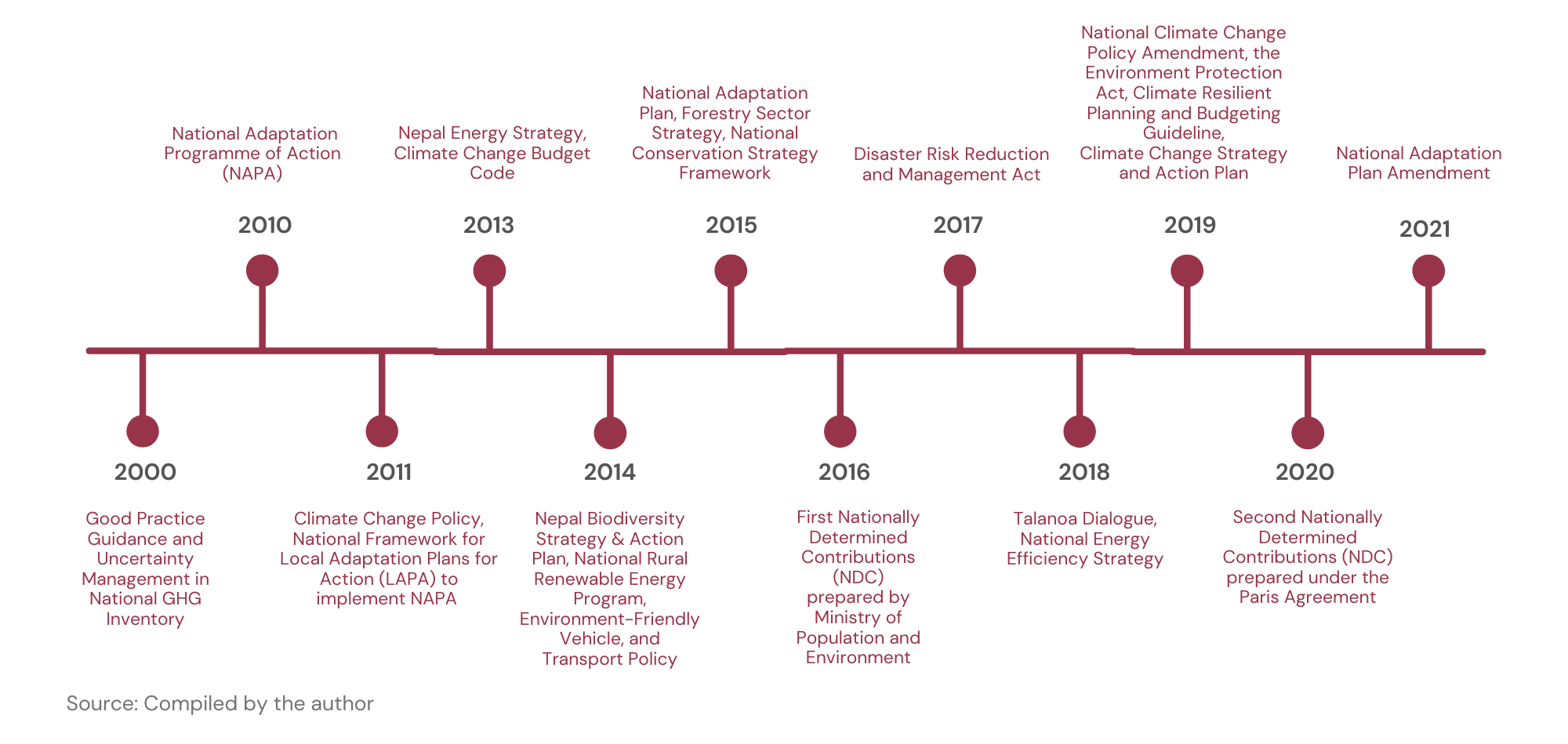Temperatures are rising globally as the earth’s average surface temperature in 2020 was the hottest year on record, and the 10 warmest years in recorded history have all occurred since 2010, continuing a long-term warming trend. Climate change is a pressing problem globally as the number of weather-related disasters that have occurred over the past 50 years has increased five-fold. Nepal is no exception to the growing frequency of hydro-meteorological extreme events such as landslides, floods, avalanches, debris flow, and heat and cold waves, which have increased by 4.31 % from 2015 to 2021. In 2021, 4,215 disasters struck Nepal, destroying 3,624 houses and killing 509 people; such catastrophic events with human casualties have significant social and economic implications. As a global commitment to mitigate, adapt and overcome challenges such as these, Nepal along with 198 other countries is part of the Conference of the Parties (COP).
The COP is a group of nations that have signed the UN Framework Convention on Climate Change (UNFCCC), set up in 1992. Over the years, significant actions have been taken place resulting in accords, agreements, funds for developing countries, and specific goals.
COP Goals
The Paris Agreement, signed in 2015 established the global climate objective of limiting global warming to 1.5°C and achieving net zero emissions by 2050. Currently, global carbon dioxide emissions remain high at a projected 40.6 billion tonnes in 2022 with no sign of a decrease. With the persisting levels of emissions, there is a 50% chance that warming of 1.5°C will be exceeded in 9 years from 2022. The recent COP27 in 2022 set out its mission in four key areas: Mitigation, Adaptation, Finance, and Collaboration to achieve the climate goals.
To achieve the ambitious global targets, countries form their voluntary pledges – known as Nationally Determined Contributions (NDCs)- to meet the agreed-on targets. Countries are free to develop a combination of policies that is the most economical, and at the yearly COP meetings, they report on whether they were successful in attaining their voluntary targets.
Figure 1: Nepal’s Climate Actions (2000 to 2021)

The Climate Commitments of Nepal
The Ministry of Population and Environment (MoPE) submitted the first NDC in October 2016, and the second NDC under the Paris Agreement for the period 2021-2030 in December 2020 which includes commitments to reducing GHG emissions, actions to adapt to the impacts of climate change, and providing necessary financial and technical support from developed countries. Nepal has stepped up its mitigation ambition by aiming to achieve net-zero GHG emissions by 2045, five years earlier than the original NDC timeline. The second NDC contains estimated implementation costs of USD 28.4 billion and includes more quantitative targets as well as wide sectoral coverage with short-term (2025) and medium-term (2030) mitigation targets, compared to the first NDC.
Table 1: Nepal’s Key NDC Targets and Achievements so far
| Sector | Targets (First NDC, 2016) | Target (Second NDC, 2020) | Achievements |
| Energy | By 2020, produce up to 4000 MW of hydroelectricity and 12,000 MW by 2030 | By 2030, expand the clean energy generation capacity to 15000 MW
By 2030, ensure 15% of the total energy demand is supplied from clean energy sources |
The total installed generation capacity is 2080 MW from hydropower and 55 MW from solar plants in 2020. |
| Transport | By 2020, increase the share of the electric vehicle up to 20% of all passenger vehicles.
By 2050, decrease the dependency on fossils in the transport sector by 50%. |
By 2030, increase the use of electric vehicles to 25% of all passenger vehicles
Increase e-vehicle sales to 90% of all private passenger vehicle sales |
The share of electric vehicles is 1% in 2020.
|
| Clean Residential Cooking | By 2030, Equip 475000 households in rural areas with clean cooking stoves and biogas to 130000 households | By 2025, install 500,000 clean cooking stoves in rural areas and install additional 200,000 household biogas plants | 34.80% have access to clean fuels for cooking as of 2020 |
| Agriculture, Forestry and Other Land Use (AFOLU) | By 2025, maintain 40% of the total area of the country under forest cover. | By 2030, maintain 45% of the total area of the country to be under forest cover. | 44.74%of the total area of the country is covered by forest as of 2020. |
Is Nepal Close to Achieving its Goals?
The national pledges are often criticized to be over-ambitious and unattainable. However, these pledges are indispensable to attaining the global climate goal. Even though Nepal contributes only 0.1% of global GHG emissions, instead of a decreasing trend, Nepal rather faced increasing rates of emissions from 26% in 2012 to 86% in 2019. The increasing trend is attributed to the transportation and industrial sector’s inability to replace the ubiquitous usage of fossil fuels and extremely old vehicles on roads emitting pollutants, implying the failure of government initiatives to promote alternative clean energy sources.
The goal of increasing forest coverage by 45% is close to being met among all 2nd NDC pledges. The government has initiatives to achieve universal access to electricity and promote electricity-based cooking by 2030. There are 344 large-scale biogas plants providing cooking gas to 300,000 rural households and the government is distributing electric stoves to students from remote areas who are studying in the valley. In regards to managing 2,233 metric tons of waste generated per year, the organic waste from Kathmandu can potentially generate 19 MW of energy if harnessed to produce bio-compressed natural gas. However, only the policy frameworks have been made regarding solid waste management.
Even though ministries, state-owned enterprises (SOEs), the private sector and development partners are working around the clock to achieve the climate goals, the goal still appears to be out of reach. In the 2022/23 budget, the excise duty on EVs with a capacity of more than 200 kilowatts was increased from 40% to 60%. Further, contrary to what was envisaged in the budget, there is a lack of initiatives to install charging stations at 50 locations throughout the country. Amid the challenge to increase e-vehicle sales to 90% of all private vehicle sales, the finance minister was involved in corruption relating to making changes in the tax rates on electric vehicles prior to presenting the fiscal budget for 2022/23. Hence, only comprehensive policy frameworks are developed, and effective implementation is fraught with difficulties.
The Climate Change Management Division (CCMD) formed under the Ministry of Forests and Environment, set up in 2018, assists three-tier federal agencies in climate governance which was previously overlooked by MoPE. Due to a lack of coordination and unclear division of responsibilities among the departments, movements in projects are protracted.
Additionally, data on natural resources, climate adaptation, and mitigation are dispersed among multiple government and non-government agencies, thereby leading to a limited basis for planning on attaining the ambitious climate goals.
To strengthen the implementation of the devised policy frameworks, sectoral ministries, subnational governments, SOEs, the private sector, and other stakeholders should have distinct functional responsibilities. A climate-specific capacity-building plan for all levels of government is needed. An integrated system to track the NDC progress of government agencies, supported by private enterprises in enhanced data generation and validation framework, would further strengthen the implementation of action plans.
Sadichchha Sanjel is a recent Economics graduate from Kathmandu University. She is currently working at Nepal Economic forum as NEF fellow and is interested in research, international relations, foreign affairs and development economics.





